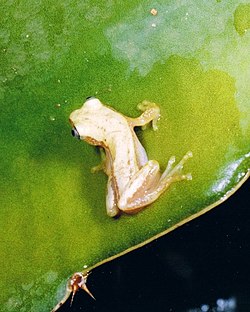Description
provided by AmphibiaWeb articles
A small, slender savanna Afrixalus (males 15-21 mm, females 17-25 mm), from eastern Africa. The gular disc is rounded to transversely oval and weakly granular. Dorsal asperities very weak, none on tibia, generally confined to head and anterior dorsum in the subspecies A. s. stuhlmanni, but abundant in the subspecies A. s. brachycnemis. Ventrally, asperities confined to the mentum. Above silvery yellow with a dark lateral band. There is a pair of slightly convergent dark lines from the rump over the back to between the eyes. Tibia has a dark band along its lower exposed surface and often an isolated longitudinally-biased dark streak in the lighter area. The subspecies A. s. brachycnemis has a more variable pattern (Pickersgill 2007).This species is referred to as Afrixalus sp. in older publications (Schiøtz 1974; Schiøtz 1999; Poynton and Broadley 1987). It has been split by Pickersgill (2005) into two subspecies: A. s. stuhlmanni from coastal Kenya to lowland eastern Tanzania, and A. s. brachycnemis from Malawi and eastern Zambia. Poynton (2006) regards the two as distinct species, however.
- IUCN, Conservation International, and NatureServe. 2006. Global Amphibian Assessment: Afrixalus stuhlmanni. www.globalamphibians.org. Accessed on 23 August 2008.
- Pickersgill, M. (2005). ''The taxonomy and ethology of the Afrixalus stuhlmanni complex (Anura: Hyperoliidae).'' Steenstrupia, 29(1), 1-38.
- Poynton, J. (2006). ''On dwarf spiny reedfrogs in Tanzanian eastern lowlands (Anura : Afrixalus) : short communication.'' African Journal of Herpetology, 55(2), 167-169.
- Schiøtz, A. (1974). ''Revision of the genus Afrixalus (Anura) in Eastern Africa.'' Vedenskabelige Meddelelser fra Dansk Naturhistorisk Forening, 137, 9-18.
Distribution and Habitat
provided by AmphibiaWeb articles
A. s. stuhlmanni occurs from coastal Kenya to lowland eastern Tanzania, and A. s. brachycnemis is known from Malawi and eastern Zambia. Both subspecies prefer grassy pools and marshes in humid shrubland, mixed farmland and savanna (IUCN 2006).
Life History, Abundance, Activity, and Special Behaviors
provided by AmphibiaWeb articles
This species breeds in marshes, shrub-dominated wetlands, and permanent pools (IUCN 2006). The voice is a series of high-pitched clicks (Pickersgill 2007). For A. s. brachycnemis, the eggs are placed on grass leaves but observations indicate that the leaves are not glued together (Schiøtz 1999).
Afrixalus stuhlmanni: Brief Summary
provided by wikipedia EN

A picture of an Afrixalus stuhlmanni brachycnemis(a species of frog in the family Hyperoliidae)
Afrixalus stuhlmanni is a species of frog in the family Hyperoliidae. It is endemic to Tanzania.
Its natural habitats are moist savanna, subtropical or tropical moist shrubland, shrub-dominated wetlands, swamps, freshwater marshes, arable land, rural gardens, urban areas, heavily degraded former forest, ponds, irrigated land, seasonally flooded agricultural land, and canals and ditches. It can tolerate many types of habitat and is common to abundant in some areas.
- license
- cc-by-sa-3.0
- copyright
- Wikipedia authors and editors


 A picture of an Afrixalus stuhlmanni brachycnemis(a species of frog in the family Hyperoliidae)
A picture of an Afrixalus stuhlmanni brachycnemis(a species of frog in the family Hyperoliidae)